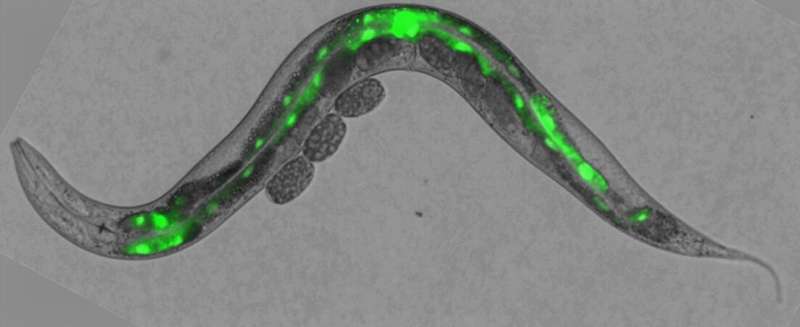New information on regulation of sense of smell with the help of nematodes

PIM kinases are enzymes that are evolutionarily well conserved in both humans and nematodes. Led by Dr. Päivi Koskinen, a research group from the Department of Biology of the University of Turku in Finland has previously proven that PIM kinases promote the motility and survival of cancer cells, but now the group has shown that these enzymes also regulate the sense of smell.
The novel results were inspired by new research tools. Koskinen's research group had assessed the efficacy of PIM-inhibitory compounds in cancer cells and decided to test whether they affect normal tissues, too.
"We especially wanted to study the regulation of olfactory neurons, since we had noticed that PIM kinases are expressed in the olfactory epithelium in mice. Instead of mice, however, we chose the invertebrate Caenorhabditis elegans nematode as our experimental organism. These little creatures have only 302 neurons, but can still efficiently distinguish between attractive or repulsive olfactory and gustatory cues in their environment, and thereby find food and avoid danger," explains Koskinen.
The C. elegans cultures in Turku were set up with the expert help by Dr. Carina Holmberg from the University of Helsinki. For the actual experiments, Dr. Karunambigai Kalichamy from India was recruited to provide further expertise on the use and behavioural analyses of these small and modest test animals.
In her chemotactic experiments, Kalichamy measured the motility of the nematodes towards or away from volatile or soluble compounds and compared untreated control animals with those treated with PIM inhibitors.
"Untreated nematodes immediately started to crawl towards attractive agents or run away from unpleasant compounds. PIM inhibitors did not affect any gustatory sensations, but significantly interfered with olfaction, so that the drug-treated animals were not able to respond to olfactory cues, but randomly moved to different directions," says Kalichamy.
These results were not simply due to off-target effects of the drugs, as similar data were obtained also when PIM expression was abrogated by targeted mutations.
"Next it would be interesting to dissect the molecular effects of the PIM kinases in more detail and find out, whether they regulate olfaction also in humans and other mammals. The results could be interesting not only to evolution biologists, but to pharma companies, too. In case the PIM inhibitors rapidly, but luckily reversibly, reduce human olfactory responses in cancer patients, this phenomenon could even be used as a biomarker to assess the efficacy of the PIM-targeted therapies that are currently being developed against several types of cancer," states Koskinen.
More information: Karunambigai S. Kalichamy et al, PIM-Related Kinases Selectively Regulate Olfactory Sensations in Caenorhabditis elegans, eNeuro (2019). DOI: 10.1523/ENEURO.0003-19.2019
Provided by University of Turku




















